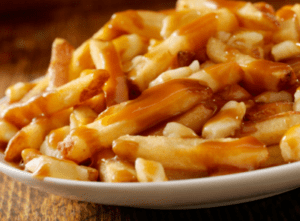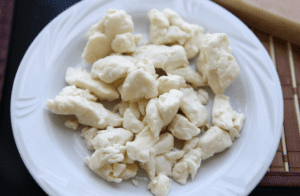Sydney Fuhrman
Watch our Education Coordinator try to make this dish for the first time:
As far as classic “Canadian” dishes go, this one is fairly modern. It was likely invented in the 1950s in Quebec and gained popularity across the province, and its neighbour Ontario in the 1980s, but this dish wasn’t consumed Canada-wide until the 1990s. Of course now, poutine is an irresistible and irreplaceable part of Canadian life and lore.
Now, I understand that poutine has its fans and its haters, but I’m originally from Ontario where poutine has been part of the culture a little bit longer, so this messy dish has a special place in my heart. It’s what you eat on a ski hill after you’ve finally peeled off your ski boots and the feeling is coming back into your feet. It’s what you get when you’re on your first trip to Quebec and you don’t want to embarrass yourself by trying to order something else in French. And it’s the only french fry based dish I will eat with a fork – you can’t get those last gravy soaked fries in the bottom of the take out container with your fingers. I’ve tried, just don’t.
little bit longer, so this messy dish has a special place in my heart. It’s what you eat on a ski hill after you’ve finally peeled off your ski boots and the feeling is coming back into your feet. It’s what you get when you’re on your first trip to Quebec and you don’t want to embarrass yourself by trying to order something else in French. And it’s the only french fry based dish I will eat with a fork – you can’t get those last gravy soaked fries in the bottom of the take out container with your fingers. I’ve tried, just don’t.
According to a poll conducted by Chatelaine Magazine, 21% of Canadians consider poutine to be their favourite Canadian dish – I’d be part of that number, if that wasn’t clear. It outstripped maple syrup and lobster. So while it isn’t the most “BC” of dishes, it just feels right to start here.
First, what exactly is poutine? I’ve been to a few restaurants that don’t seem to actually know the answer so I think an explanation is necessary. Poutine is a simple dish of french fries, cheese curds and gravy. The gravy is usually a thin, brown version made with chicken broth, or a sauce brune, which is made from a combination of chicken and beef stock. The exact gravy recipe changes depending on who makes it. The real trick is the curds.
 Cheese curds are bits of curdled milk that are created as a by-product of the cheese making process. They have a very specific taste and texture and are best consumed within hours of being made – so it isn’t easy to get them if you’re far from a dairy. You can tell if the curds are fresh if they squeak when you bite into them, hence their other name “squeaky cheese.” To this day cheese curds are a popular snack in eastern Canada, particularly in Quebec. And with 81% of Canada’s current dairy farms being in Quebec and Ontario, odds are you aren’t ever far from somewhere that makes them, so it’s not surprising that this dish is from La belle province.
Cheese curds are bits of curdled milk that are created as a by-product of the cheese making process. They have a very specific taste and texture and are best consumed within hours of being made – so it isn’t easy to get them if you’re far from a dairy. You can tell if the curds are fresh if they squeak when you bite into them, hence their other name “squeaky cheese.” To this day cheese curds are a popular snack in eastern Canada, particularly in Quebec. And with 81% of Canada’s current dairy farms being in Quebec and Ontario, odds are you aren’t ever far from somewhere that makes them, so it’s not surprising that this dish is from La belle province.
The story of poutine’s invention is about as messy as those last gravy soaked fries (seriously, you need a fork – or even a spoon). Poutine is undoubtedly a Quebecois dish, but there are a few different people that claim to be it’s creator. The two most likely originators seem to be Ferdinand Lachance of Café Ideal, renamed Le Lutin Qui Rit in Warwick, Quebec and Jean-Paul Roy of Le Roy Jucep, in Drummondville, Quebec. Both are in the Centre-du-Québec region of the province and are within an hour’s drive of each other.
Café Ideal’s story is that in 1957 a regular customer asked Lachance to add locally produced cheese curds to a serving of fries. After Lachance heard this request he exclaimed “Ça va te faire une maudite poutine!” – “That will make a damned mess!” Despite this, Lachance made the order and next thing he knew the fries and curds combination became a popular request. A while later some customers started saying that the fries got cold too quickly, so Lachance added gravy to solve that particular problem, creating the dish we now know and love.
Alternatively, Jean-Paul Roy claimed that he had been serving fries with his special “patate-sauce” at his snack bar since 1958. When some of his customers asked that their bag of local cheese curds, also served at the snack bar, be added to their bag of fries and sauce, Roy added it to the menu and called it “fromage-patate-sauce”. “Poutine” was regional slang for “pudding,” “mix” or “mess” and overtime it became the name for the dish because wait staff found it annoying to write out “fromage-patate-sauce” every time someone ordered this popular dish. Also, “Ti-Pout” was a nickname for one of the cooks who made the dish, so the name could also have been inspired by him.
These aren’t even the only two places that claim to have invented this delicious mess! We will probably never know for sure who first came up with the idea, but Le Roy Jucep is the only place with the registered trademark for the title of “L’Inventeur de la Poutine.”
Regardless of which Quebec location started everything, poutine has taken the country and the world by storm. By the 1980s it was a staple in snack bars and chip trucks across Quebec and Ontario and in the early 1990s a few well known fast food restaurants began offering it on their menus across Canada. In the 2000s, high-class twists began starring on menus of fine-dining establishments and even a few poutine-only restaurants have appeared, serving a variation for every palate.
Poutine has come a long way from only being cheese curds and gravy. The variations now range from wonderful to weird. I once had a poutine made with pierogies instead of fries, and in 2017 Tim Hortons even released a poutine doughnut – I did not try this one as interestingly enough, it was only released in the United States. Make of that what you will.
Canada is a huge and diverse country and it can be difficult, if not impossible, to truly identify what “Canadian Culture” is. What someone here in Sidney thinks is quintessentially Canadian is probably different from what someone in Moncton, New Brunswick thinks. But, like it or not, poutine has become something that Quebec and Canada is known for the world over.
Try to make this mess yourself. Be sure to share on social media whatever you create and tag the Sidney Museum.
Facebook: @SidneyMuseum, Twitter: @SidneyMuseum, Instagram: @sidneymuseum
Poutine
Adapted from Chuck Hughes’ Food Network’s recipe.
Ingredients
- 6-8 large Yukon gold potatoes, cut into ¼ inch thick fries
- 1 tbsp vegetable oil, plus more for frying
- 1 shallot, minced
- 1 garlic clove, minced
- 2 cups chicken stock
- 2 cups beef stock
- 2 tbsp tomato paste
- 1 tbsp apple cider vinegar
- 1 tbsp peppercorns
- ½ tsp Worcestershire sauce
- 2 tbsp butter
- 2 tbsp all-purpose flour
- Salt and pepper to taste
- 2 cups cheese curds
Method
- Let the fries soak in a large bowl of cold water for at least an hour. Drain well and pat dry.
- Heat 1 tbsp of the oil in a saucepan over medium heat. Add the shallot and garlic, sauté for about 3 minutes – until translucent. Stir in the stocks, tomato paste, vinegar, peppercorns and Worcestershire sauce and bring to a boil.
- In a different saucepan, melt the butter over medium-high heat. Then add the flour, stirring until just browned, about 2-3 minutes. Be careful not to get any of this on your skin. Then carefully add the stock mixture into the roux one ladleful at a time, whisking as you go. Simmer for about 20 minutes, until the gravy is reduced by half. Add salt and pepper to taste and keep warm
- Line a baking sheet or other heatproof dish with paper towels. In a large, heavy-bottomed pot, heat 2-3 inches of vegetable oil over medium-high heat until it reaches 350 degrees F. Fry the soaked and drained potatoes in batches for about 8 minutes. Remove with a strainer and set them on the paper towels. Once all the fries have been cooked, raise the oil temperature to 375 degrees F over high heat. Fry the potatoes again, in batches for another 6 to 8 minutes, until they are golden brown.* Drain on new paper towels. Salt and pepper the potatoes to taste while they are still warm. Strain the warm gravy
- Assemble your poutine: Fries, then curds, then gravy. Serve immediately.
Serves 3-4 people
*Timing is just a suggestion – be sure to keep an eye on the colour of the fries as they cook.